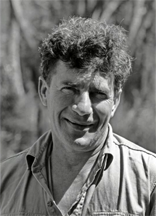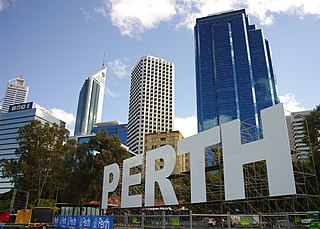
John Forrest National Park is a national park in the Darling Scarp, 24 km (15 mi) east of Perth, Western Australia. Proclaimed as a national park in November 1900, it was the first national park in Western Australia.

The Darling Scarp, also referred to as the Darling Range or Darling Ranges, is a low escarpment running north–south to the east of the Swan Coastal Plain and Perth, Western Australia. The escarpment extends generally north of Bindoon, to the south of Pemberton. The adjacent Darling Plateau goes easterly to include Mount Bakewell near York and Mount Saddleback near Boddington. It was named after the Governor of New South Wales, Lieutenant-General Ralph Darling.

The Royal Australasian Ornithologists Union (RAOU), now part of BirdLife Australia, was Australia's largest non-government, non-profit, bird conservation organisation. It was founded in 1901 to promote the study and conservation of the native bird species of Australia and adjacent regions, making it Australia's oldest national birding association. In 1996, the organisation adopted the trading name of Birds Australia for most public purposes, while retaining its original name for legal purposes and as the publisher of its journal, the Emu. In 2012, the RAOU merged with Bird Observation & Conservation Australia to form BirdLife Australia.

Penguin Island is a 12.5-hectare (31-acre) island off the coast near Perth, approximately 660 metres (722 yd) from Shoalwater. It is home to a colony of 300 little penguins, the largest population of the birds in Western Australia. Since 2007, the island had experienced an 80 percent decline in penguin numbers in 2019 from a peak of 1,600 that year.

Cunderdin is a town located in the Wheatbelt region of Western Australia 156 km east of Perth, along the Great Eastern Highway. Due to it being on the route of the Goldfields Water Supply Scheme it is also on the Golden Pipeline Heritage Trail. It is a rural community consisting of a district high school and an agricultural college.
The Western Australian Museum is a statutory authority within the Culture and the Arts Portfolio, established under the Museum Act 1969.
Scouting in Western Australia is predominantly represented by a branch of Scouts Australia and Girl Guides Western Australia, a member organisation of Girl Guides Australia.

Railways in Western Australia were developed in the 19th century both by the Government of Western Australia and a number of private companies. Today passenger rail services are controlled by the Public Transport Authority through Transperth, which operates public transport in Perth, and Transwa, which operates country passenger services. Journey Beyond operates the Indian Pacific.

Vincent Noel Serventy AM was an Australian author, ornithologist and conservationist.
The Conservation Council of Western Australia is the umbrella body for conservation groups and organisations in Western Australia. It has been the co-ordinator, publisher and guiding body for issues of woodchipping in the South West of Western Australia, the logging of old growth forests, as well as providing input into government processes involved with all aspects of environmental protection and conservation.
Robert Litchfield Juniper, AM was an Australian artist, art teacher, illustrator, painter, printmaker and sculptor.
The Geelong Field Naturalists Club (GFNC) is an Australian regional amateur scientific natural history and conservation society which was founded in 1961. It is based in Geelong, Victoria, with the aims of:

In 1929, Western Australia (WA) celebrated the centenary of the founding of Perth and the establishment of the Swan River Colony, the first permanent European settlement in WA. A variety of events were run in Perth, regional areas throughout the state, and even across Australia such as the Western Australian Centenary Air Race.

The Esplanade Reserve in Perth, Western Australia, was a heritage listed public space between Perth Water and the Perth central business district. The public space was resumed by the Western Australian state government in April 2012 as part of the Elizabeth Quay redevelopment of the Perth waterfront area.
The Queensland Naturalists' Club Inc. was founded in Queensland as the Queensland Field Naturalists Club in 1906 to encourage the study, appreciation and preservation of Queensland’s flora and fauna and its environments. It has been known as the Queensland Naturalists Club from 1922. The Queensland Gould League of Bird Lovers joined the club in 1922. It organises field trips and excursions. The club is a member of the Australian Naturalists' Network.
The Castlemaine Field Naturalists Club (CFNC) is an Australian regional natural history society dedicated to the study, appreciation and conservation of the natural environment in the Castlemaine region of Victoria. Founded in 1976, the CFNC has played a pivotal role in promoting environmental awareness and scientific enquiry within the Castlemaine community.
The Latrobe Valley Field Naturalists Club is an Australian regional scientific natural history and conservation society. It is based in the Latrobe Valley in Victoria and draws members from across western, central and southern Gippsland.
The Ringwood Field Naturalists Club (RFNC) is an Australian regional scientific natural history society, dedicated to the study, appreciation and conservation of the natural environment. It is based in Ringwood in Melbourne's eastern suburbs. Founded in 1961, the club has played a pivotal role in promoting environmental awareness and scientific enquiry within the community. The club continues to host meetings for people within the region to share and explore their interest in Australian Natural History.
The Peninsula Field Naturalists' Club (PFNC) is an Australian regional scientific natural history and conservation society. The club is located on the Mornington Peninsula in Victoria.
The Bendigo Field Naturalists Club (BFNC) is an Australian regional scientific natural history society, dedicated to the study, appreciation and conservation of the natural environment. It is located in Bendigo, in central Victoria and focuses on the native biodiversity of the Bendigo Valley.











